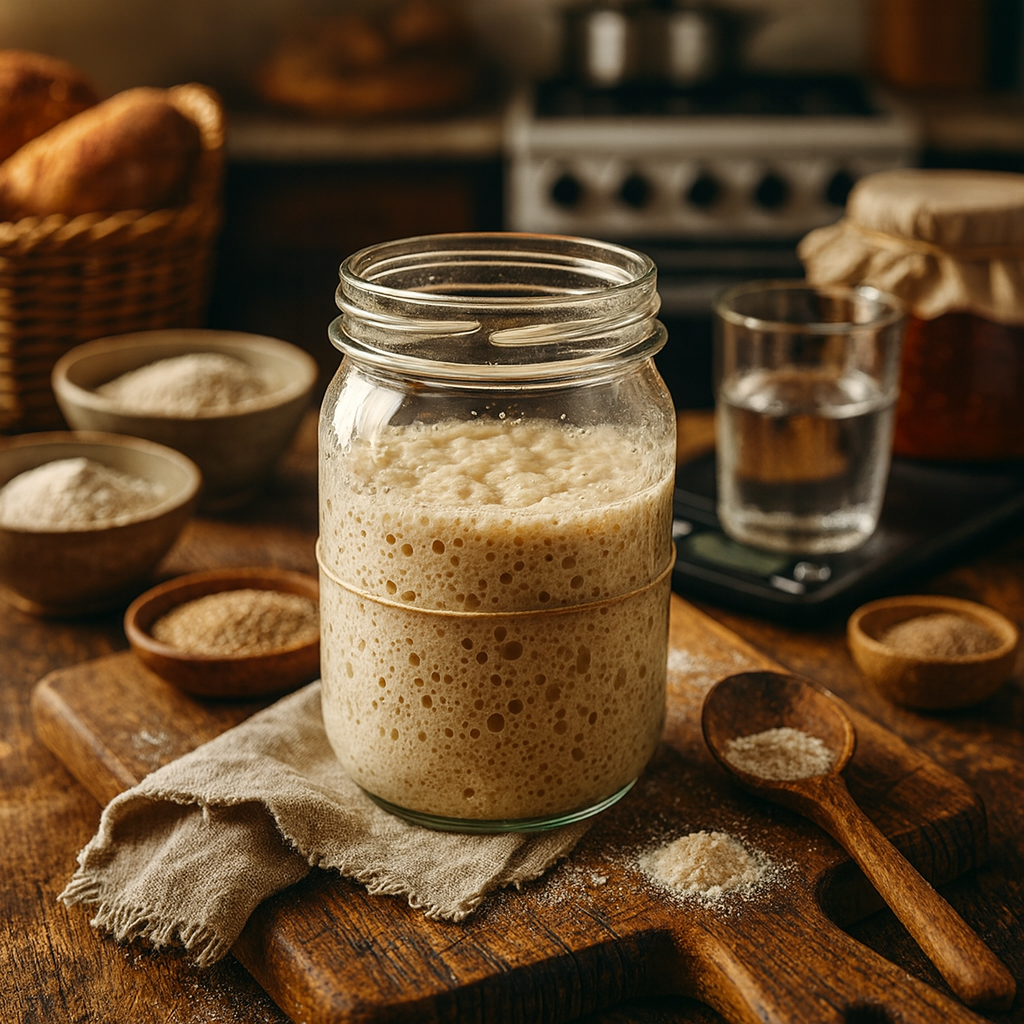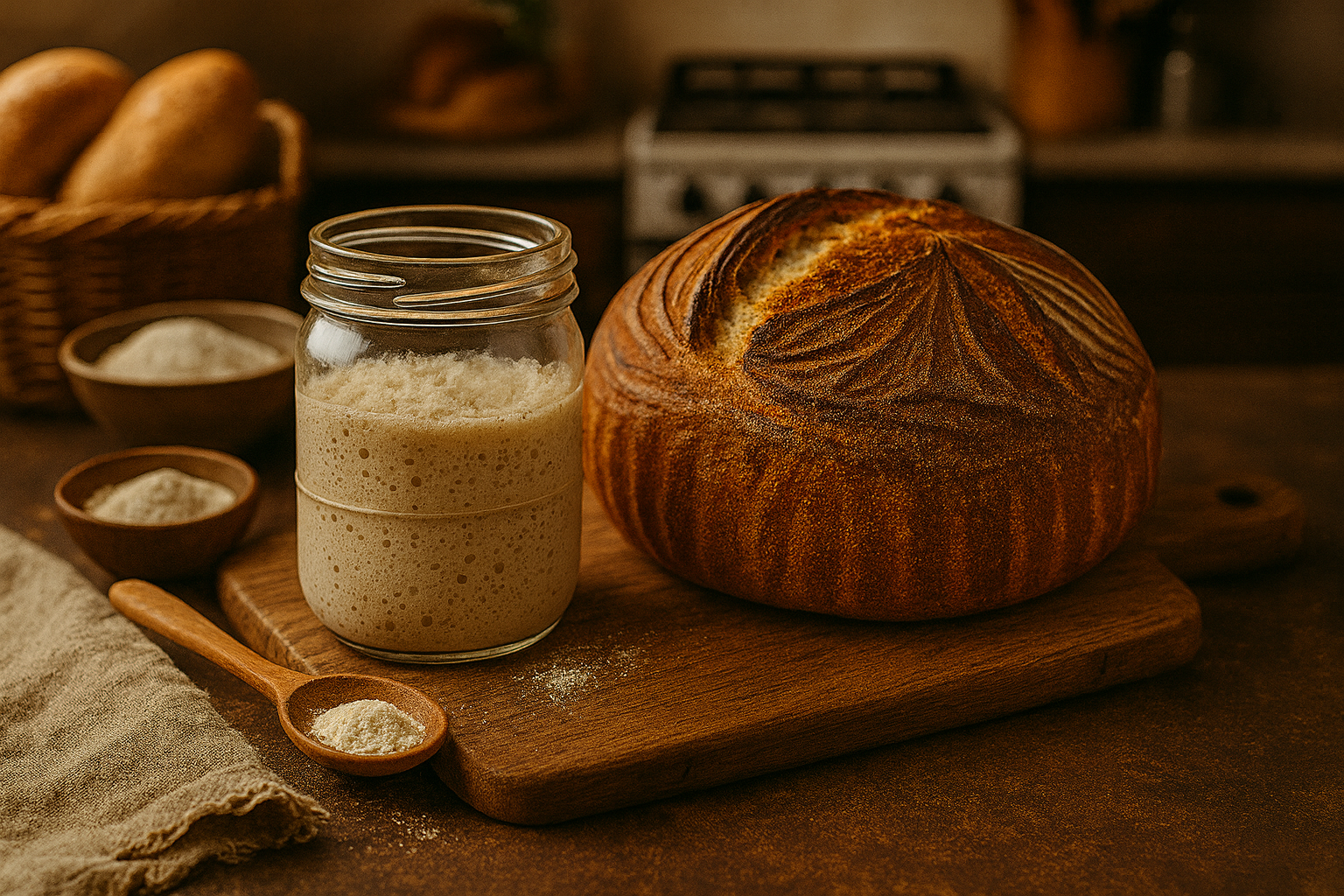Table of Contents
Introduction to Sourdough Bread
Sourdough bread is a distinctive type of bread characterized by its unique fermentation process and flavorful profile. Unlike conventional bread, which typically rises primarily due to commercial yeast, sourdough relies on wild yeast and lactic acid bacteria present in the environment and flour. This natural leavening process creates a complex flavor and contributes to the bread’s characteristic tanginess. The fermentation involved in making sourdough not only enhances its taste but also results in a unique texture, making it a preferred choice among many bread enthusiasts.
The primary ingredients of sourdough bread include flour, water, and salt, along with the sourdough starter, which is a mixture of flour and water that has fermented over time. This starter serves as the leavening agent, with the wild yeast and bacteria thriving in the mixture, resulting in a naturally tangy flavor profile that distinguishes sourdough from other types of bread. Whole grain flours, such as whole wheat or rye, are often used, lending additional nutritional benefits and flavors that further enhance the sourdough experience.
In recent years, sourdough bread has gained significant popularity among those seeking healthier dietary options. Many individuals are drawn to its artisan qualities and health benefits, including improved digestibility and a potentially lower glycemic index compared to regular bread. Additionally, the long fermentation process helps to break down gluten, which some people find easier on the stomach, though it is essential to note that sourdough bread is not gluten-free. As sourdough continues to capture the interest of bakers and consumers alike, its appeal lies in both its rich history and its modern resurgence in the bread-making world.

Understanding Gluten and Its Effect on Health
Gluten is a group of proteins primarily found in wheat, barley, and rye. It plays a crucial role in the baking process, providing elasticity and strength to dough, which allows bread to rise and maintain its shape. This unique property of gluten makes it essential for creating various baked goods, from artisan bread to pastries. During fermentation, gluten interacts with yeast, contributing to the distinct texture and taste of these products.
For many individuals, particularly those without any gluten-related health issues, gluten poses no harm and can be consumed safely. However, an increasing number of people are diagnosed with gluten intolerance or celiac disease. This autoimmune disorder occurs when the ingestion of gluten leads to damage in the small intestine, resulting in various health complications. Symptoms can manifest in diverse ways, including gastrointestinal distress, fatigue, skin rashes, and neurological issues. These symptoms stem from the immune system’s reaction to gluten, which causes inflammation and disrupts the proper function of the digestive tract.
Gluten intolerance is more common and varies in severity compared to celiac disease. Individuals with gluten sensitivity might experience discomfort and other symptoms without the autoimmune response or intestinal damage characteristic of celiac disease. It is important for those experiencing symptoms related to gluten consumption to consult with a healthcare professional for proper diagnosis and management strategies.
In summary, while gluten is a fundamental component of traditional bread making, its impact on health needs careful consideration for those who are sensitive to it. Understanding gluten and its effects is essential for individuals to make informed dietary choices, particularly when considering alternatives such as sourdough or gluten-free bread options.
Is Traditional Sourdough Bread Gluten-Free?
Traditional sourdough bread, which is primarily made from wheat flour, is not considered gluten-free. Gluten is a protein found in wheat, barley, and rye, and it gives bread its characteristic elasticity and structure. The fermentation process involved in making sourdough does alter the gluten content, but it does not eliminate it entirely. During fermentation, naturally occurring lactic acid bacteria and yeasts break down some of the gluten and other compounds within the dough. This extended fermentation can make the gluten easier to digest for some individuals, particularly those with mild gluten sensitivities. However, this does not make the bread suitable for those with celiac disease or a severe gluten intolerance, as it retains a substantial amount of gluten.
The fermentation process in sourdough is unique, as it typically lasts longer than that of commercial bread production. This lengthy fermentation contributes to the distinctive flavor and texture of sourdough while simultaneously breaking down certain complex carbohydrates, which can result in lower levels of gluten than conventional bread. Even so, the reduction is not sufficient to classify traditional sourdough as gluten-free. Research has indicated that even long-fermented sourdough bread can contain gluten levels that exceed the acceptable threshold for gluten-sensitive individuals.
It is critical for anyone with celiac disease or a diagnosed gluten sensitivity to avoid consuming traditional sourdough made with wheat flour. While some people might experiment with sourdoughs made from gluten-free grains, these variations do not showcase the canonical sourdough process and differ significantly in taste and texture. In essence, if you are seeking gluten-free options, traditional sourdough bread should be excluded from your diet.
Sourdough Alternatives for Gluten-Free Diets
For individuals adhering to a gluten-free diet, traditional sourdough bread is not a viable option due to its wheat content. However, the market has responded to this need by developing a variety of gluten-free sourdough alternatives. These options typically utilize alternative flours like rice, almond, or buckwheat, which do not contain gluten yet still allow for a similar texture and taste profile found in conventional sourdough.
One popular gluten-free sourdough bread option is made from brown rice flour combined with a gluten-free sourdough starter. This type of bread often exhibits a delightful tangy flavor characteristic of sourdough while remaining safe for those with gluten sensitivities. Similarly, almond flour sourdough tends to be denser and richer, appealing to those looking for a nutritious alternative.
Buckwheat is another excellent choice, despite its name. It is gluten-free and can impart a slightly nutty flavor, making it a delightful option for sourdough. There are numerous recipes available that combine buckwheat flour with other gluten-free flours to enhance the texture and overall quality of the bread. For instance, blends of buckwheat and tapioca flour can lead to a loaf that is both flavorful and pleasantly chewy.
Several brands market gluten-free sourdough breads as well. For instance, Dave’s Killer Bread offers a gluten-free option that many consumers enjoy for its taste and texture. Additionally, local artisan bakeries may create small batches of gluten-free sourdoughs, often using a combination of the aforementioned flours. Baking at home is also an option, with many recipes readily available online, guiding individuals to make their own gluten-free versions.
Overall, the rise of gluten-free sourdough alternatives presents a diverse range of options for those on gluten-restricted diets, ensuring that everyone can partake in the unique experiences that sourdough bread offers.
The Fermentation Process: Does it Reduce Gluten Content?
Sourdough bread is distinct from conventional bread primarily due to its fermentation process, which involves the natural leavening by wild yeast and lactic acid bacteria. This process not only transforms the texture and flavor of the bread but also has implications for its gluten content. During fermentation, the enzymes released by these microorganisms break down some of the gluten proteins present in the dough. This breakdown can result in a significant reduction of gluten, potentially making sourdough bread easier to digest for some individuals.
Research suggests that the specific strains of bacteria prevalent in sourdough fermentation may have unique capabilities to degrade gluten. A study published in the “Journal of Science and Food Agriculture” demonstrated that the lactic acid bacteria can hydrolyze gluten to smaller peptides and amino acids, thereby reducing the quantity of intact gluten proteins in the final product. This biochemical interaction indicates that sourdough baking could be more suitable for those with mild gluten sensitivities, though it is crucial to emphasize that sourdough is not gluten-free.
It is also important to consider the duration of fermentation. A longer fermentation period often results in greater gluten breakdown, which is an essential factor for those who experience discomfort when consuming gluten. However, while some may find sourdough more palatable, individuals with celiac disease should exercise caution. The presence of even trace amounts of gluten can provoke a reaction, thus sourdough may not serve as a safe alternative.
In conclusion, the fermentation of sourdough bread does appear to reduce gluten content through natural enzymatic processes, making it potentially more digestible for some. Yet, it is vital to acknowledge that it is not entirely gluten-free, and those with gluten intolerance or celiac disease should still approach sourdough cautiously.
Cross-Contamination in Sourdough Production
For individuals with gluten sensitivities or celiac disease, the issue of cross-contamination in sourdough bread production is of paramount importance. Sourdough, a traditionally fermented bread made from a mixture of flour and water, often utilizes wheat-based ingredients, which inherently contain gluten. Therefore, when sourdough is produced in environments where gluten-containing products are also handled, the risk of cross-contact arises.
In commercial bakeries, the likelihood of cross-contamination can be particularly high. Equipment such as mixers, proofers, and ovens may have residual gluten from previous batches of non-gluten-free bread. Even if the sourdough bread itself is prepared with gluten-free flours, the proximity to gluten-containing ingredients can lead to contamination. It is essential for those who require gluten-free options to confirm that a bakery implements strict segregation practices. This can include using dedicated equipment, clearly labeling gluten-free products, and training staff to understand the importance of avoiding cross-contact.
Home bakers, while having greater control over their ingredients and equipment, must also be vigilant. Utilizing thoroughly cleaned tools and surfaces, as well as storing gluten-free ingredients separately, helps minimize contamination risks. Moreover, sourcing gluten-free certified flours can provide an added safety layer, ensuring that the product is suitable for those with gluten-related disorders.
In summary, the safety of sourdough bread for gluten-sensitive individuals hinges on the production practices employed, whether in bakeries or at home. Awareness of cross-contamination risks and adherence to best practices are essential for producing a truly gluten-free sourdough product, allowing individuals with gluten sensitivities to enjoy this cherished bread without health concerns.
FAQ on Sourdough Bread and Gluten
Q1. Can I eat sourdough if I have gluten sensitivity?
Traditional sourdough bread is made from wheat flour, which contains gluten. The fermentation process does break down some gluten proteins, which might make it easier for people with mild gluten sensitivity to digest. Still, it isn’t risk-free. If you have gluten sensitivity or celiac disease, always check with your doctor before adding sourdough to your diet.
Q2. Does gluten-free sourdough exist?
Yes. Gluten-free sourdough is made using alternative flours such as rice, sorghum, buckwheat, or almond flour. These breads still rely on a starter and fermentation process for flavor and texture but are completely gluten-free when prepared with certified gluten-free ingredients.
Q3. How do I know if sourdough is gluten-free?
Look for labels or certifications on store-bought bread. If you’re making it at home, ensure all ingredients are certified gluten-free. Also, take precautions against cross-contamination—use clean kitchen tools, separate utensils, and dedicated storage for gluten-free flours.
Q4. Is sourdough healthier than regular bread?
Sourdough often has a lower glycemic index compared to standard bread, meaning it can be gentler on blood sugar levels. Fermentation may also make nutrients like iron and zinc easier to absorb. That said, health benefits depend on the flour used and whether the bread is gluten-free.
Q5. Why do some people with gluten sensitivity tolerate sourdough better?
During fermentation, gluten and other proteins are partially broken down, which can make digestion easier for some with mild sensitivities. However, gluten is not fully removed, so traditional sourdough remains unsafe for those with celiac disease.
Q6. Can celiacs eat traditional sourdough?
No. Even though the fermentation reduces gluten levels, sourdough made with wheat, barley, or rye still contains gluten. People with celiac disease should stick to certified gluten-free sourdough recipes or products.
Q7. What flours are best for gluten-free sourdough?
Brown rice, sorghum, buckwheat, teff, millet, and almond flour are common choices. Many bakers combine them for better texture, rise, and flavor.
Q8. Does gluten-free sourdough taste different?
Yes. It usually has a denser texture and a slightly different flavor compared to wheat-based sourdough. Using a blend of gluten-free flours often helps mimic the airy crumb and tangy flavor people love in traditional sourdough.
Q9. How can I avoid gluten cross-contamination at home?
- Dedicate a toaster or bread knife only to gluten-free bread.
- Use separate bowls, spoons, and pans for gluten-free baking.
- Clean countertops carefully.
- Store gluten-free flours in sealed containers away from wheat flour.
Conclusion: Making Informed Choices
In light of the discussions surrounding sourdough bread and its gluten content, it is essential for individuals, particularly those with gluten sensitivities or celiac disease, to approach their dietary choices with careful consideration. Traditional sourdough bread, made from wheat or rye, does contain gluten. However, the fermentation process involved in sourdough may offer certain benefits that make it more tolerable for some people. The long fermentation process breaks down some gluten proteins, which can lead to improved digestibility compared to standard bread. Nonetheless, this does not make it gluten-free, and individuals who strictly avoid gluten must be vigilant.
For those on a gluten-free diet, alternative options such as gluten-free sourdough loaves made with alternative flours like rice, almond, or chickpea flour are available. These options provide a way to enjoy the unique flavors and textures associated with sourdough without compromising dietary restrictions. It is crucial for consumers to read labels and inquire about the ingredients and the preparation methods used to ensure that the gluten-free claims are valid.
Moreover, consulting with healthcare professionals, such as a registered dietitian, can provide personalized guidance and recommendations tailored to individual health needs. They can help navigate the complexities surrounding gluten and sourdough, assisting in making informed dietary choices. By understanding the differences and being aware of the various gluten-free options, individuals can enjoy a diverse and nutritious diet while adhering to their health requirements.




